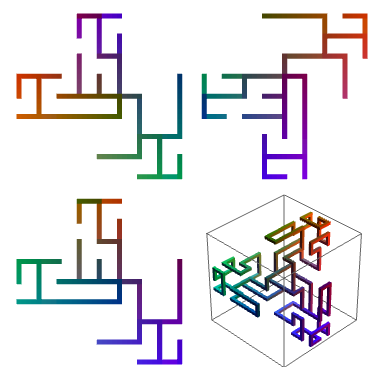Now that the year is drawing to a close, there are a few things worth discussing. Firstly, cp4space has a total of over 20000 views and a new seasonal banner (see above)!
Mathematica 9
The Treefoil has been mentioned on mathpuzzle.com. I updated the page to reflect the optimised 9-by-9-by-9 Treefoil, rendered below using Wolfram Mathematica 8:
It turns out that a composite function I defined (to draw a three-dimensional binary array as an arrangement of cubes) has now been added to the native instruction set of the newly-launched Mathematica 9. Here’s a screenshot from the Wolfram Blog showcasing this new command:

One of the many new features of Wolfram Mathematica 9
Cipher Tuesday
I’m pleased with how well the weekly cipher challenges are going. The next one goes online at 00:01 GMT on the 1st January 2013, so if you’re in another time zone you can celebrate the new year without sacrificing your chances of being the first to solve it.
Things became interesting in November, when Vishal Patil and Sam Cappleman-Lynes decided to compete to solve as many ciphers as possible. Vishal solved the fifth cipher first, but Sam has since overtaken him and is now in a comfortable first position. Due to Vishal’s Python breaking (I hope he meant the programming language!), Joseph Myers and Maria Holdcroft have been able to overtake.
Of course, the situation may change after the next cipher is published. The leaderboard reflects the current status of which ciphers have been solved by whom.
Turing and turing
As you know, 2012 was the centenary of the birth of Alan Turing. There has been lots of well-deserved hype surrounding this, including a petition to place Alan Turing on the new £10 note. There was partial success in this direction, in that a special Bletchley Park edition of the board game Monopoly included money featuring the father of computer science*.
Donald Knuth (responsible for LaTeX and Knuth’s up-arrow notation, amongst other things) has suggested the verb ‘to ture‘ as a back-formation of Turing. He defined it as ‘to use the Internet’, thereby filling a semantic hole in the English language. Note that in the Aperiodical article, they have included his middle initial: ‘Donald A. Knuth’. It’s pleasing to see that I’m not the only middle-initialism-ist**.
The idea of back-formating† a surname to create a verb is not completely original. Whilst in a pub in Oundle, James D. Cranch contemplated the meanings of the verbs ‘to gouch’ and ‘to gendle’. The latter has since been accepted to refer to a technique of questionable legality in the game of Ultimate Frisbee, whereas my name does not yet have any semantic value. If you have any proposals, please suggest them in the ‘comments’ section of this post.
Footnotes for this section
* You could argue that either Charles Babbage or John von Neumann could warrant this title. For the former, I disagree on the grounds that whilst Babbage did design the first programmable computer (again, this can be debated; the Jacquard loom accepted a sequence of instructions, but it wasn’t used for computation so I’m not including it), he didn’t formulate the concept of universality. As for von Neumann, his research post-dated Turing’s.
** I’m not responsible for this clumsy hyphenated mess, by the way, but I choose to accept it for the sake of historical consistency.
† Yes, that was deliberately ironic and self-referential†.
Museum of Mathematics
The Museum of Mathematics opened in New York City. It is of a similar style to the earlier Eames Mathematica exhibit (bizarrely, neither related to Suzanna E. Eames nor to the aforementioned Wolfram Mathematica), featuring visual and interactive demonstrations. It’s best demonstrated by the following video:
[youtube=http://www.youtube.com/watch?v=jK7xPo1YXzY]
The museum (affectionately known as MoMath) was designed by the geometer George W. Hart. You may know him from his amazing work in polyhedra (both research and art), or via his daughter Vi. He uses 3D printing technology (which is becoming increasingly popular) to produce some elegant polyhedral sculptures. I intend to do use similar methods to build copies of a polyhedral {sculpture, knot-theoretic link, puzzle, proof that A5 is isomorphic to I, promotional item, …} to offer as prizes for the EGMO. I’ll elaborate on this very shortly…


‘To gouch’ is a real verb, meaning to become drowsy due to the effect of narcotics. I assume this isn’t relevant…
Interesting. The definitions provided on Urban Dictionary (http://www.urbandictionary.com/define.php?term=to%20gouch) and Collins Dictionary (http://www.collinsdictionary.com/submission/4572/gouch) are also derogatory, as is the Irish insult ‘goucher’. This doesn’t bode well for me…
Reach truck – This one is a variant on a Rider Stacker forklift, designed for small aisles, usually electrically powered, named because the forks can extend to
reach the load. The most important thing to be taken into consideration is the essential intensive cleaning
of materials handling equipment, in order to ensure that
the products are not damaged during handling, processing, and storage, and
during the distribution as well. For this reason forklifts operators must be properly trained
in the operation of the specific vehicles they are to operate.
SPAM SPAM SPAM SPAM
Greetings from Colorado! I’m bored to death at work so I decided to browse
your website on my iphone during lunch break. I love the information you present here and can’t wait to
take a look when I get home. I’m shocked at how fast your blog loaded on my cell
phone .. I’m not even using WIFI, just 3G ..
Anyways, awesome blog!